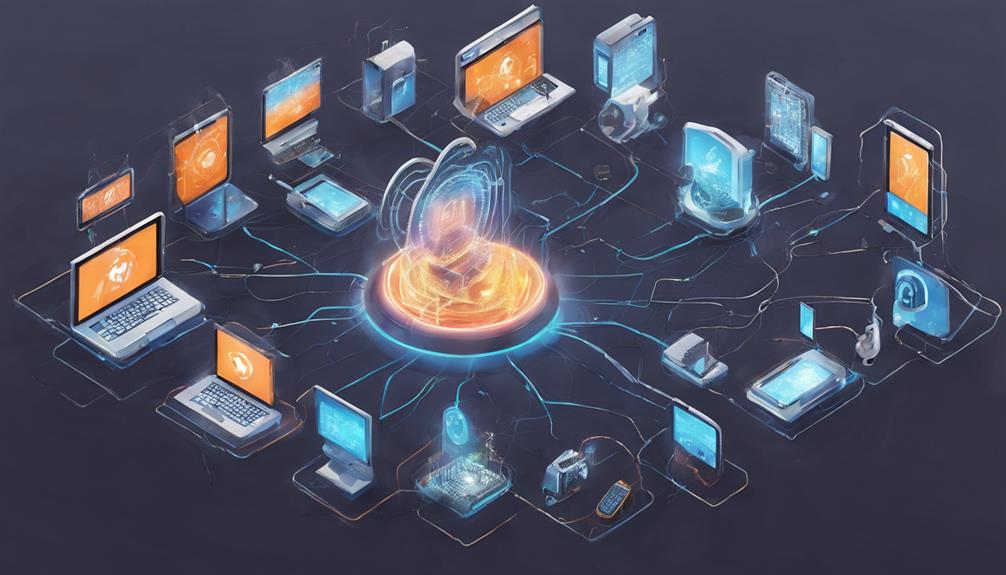To keep your email safe from hackers, use unique passwords with a password manager. Enable two-factor authentication for an added layer of security. Install strong antivirus software and keep it updated to prevent malware attacks. Use secure Wi-Fi networks and avoid public connections. Regularly update your system and be cautious of phishing emails. Monitor your email activity for any unusual behavior. Implementing these expert strategies will greatly enhance your email security.
Key Takeaways
- Use a password manager for unique passwords.
- Enable two-factor authentication for added security.
- Install strong antivirus software and keep it updated.
- Secure Wi-Fi networks and avoid public connections.
- Regularly update systems and software for protection.
Password Management
One effective strategy for enhancing email security is through meticulous password management. Password managers play an important role in this process by generating and storing unique passwords for each account, greatly reducing the risk of email hacking.
By setting a strong master password for the password manager, overall account security is enhanced, as it acts as a barrier against unauthorized access to stored passwords.
Using the same password for multiple accounts can leave individuals vulnerable to hacking attempts, making the use of password managers even more vital. These tools eliminate the need to remember multiple complex passwords by generating and securely storing them.
The unique passwords created by password managers serve as a protective shield for email accounts, safeguarding them from potential breaches and unauthorized intrusions.
Two-Factor Authentication

Enhancing email security can be effectively achieved through the implementation of two-factor authentication (2FA), a method that adds an additional layer of protection beyond just passwords. By requiring a second form of identification, such as a code sent to your phone or biometric verification, 2FA helps prevent unauthorized access to your email account, even if your password is compromised.
Many email providers offer 2FA options to their users, making it easier to set up this extra layer of security. Implementing 2FA notably reduces the risk of unauthorized access, enhancing the overall security of your email account. With 2FA enabled, you can receive alerts for any suspicious login attempts, ensuring that access to your email account is granted only with your permission.
Embracing two-factor authentication is a proactive step towards safeguarding your sensitive information from potential cyber threats.
Antivirus Protection

Antivirus protection is essential for safeguarding your email against malware and cyber threats. Strong antivirus software helps detect and remove malicious programs, ensuring your email security remains intact.
Regular security updates and email encryption techniques further enhance the defense against potential hacker attacks.
Strong Antivirus Software
Implementing reliable antivirus software is essential for safeguarding your email accounts against malware and cyber threats. Antivirus software serves as an important defense mechanism, detecting and removing malicious software that could compromise your email security.
This protection is essential in preventing phishing attacks, where hackers attempt to deceive you into revealing sensitive information. Regularly updating your antivirus software is key to ensuring it can effectively combat the latest threats targeting your email.
By scanning incoming emails for potential threats, antivirus protection acts as a barrier, safeguarding your inbox from harmful attachments or links that may contain malware. Investing in reputable antivirus software is a proactive measure that strengthens your overall email security posture, helping to fortify your defenses against hackers and their malicious attempts to infiltrate your email accounts.
Stay vigilant and prioritize strong antivirus protection to keep your email communications safe and secure.
Regular Security Updates
To maintain a strong defense against potential email security breaches, ensuring regular updates for your antivirus software is vital. Antivirus software plays an essential role in protecting your email from malware and cyber attacks. Security patches included in antivirus updates help shield your email from evolving hacker tactics that aim to compromise your security.
Failing to update your antivirus software regularly can leave your email vulnerable to various cyber threats, emphasizing the importance of staying up-to-date with the latest protection measures. By consistently updating your antivirus software, you enhance your email security and ensure that it remains robust against emerging malware infiltration attempts.
Email Encryption Techniques
Email encryption techniques play an important role in protecting sensitive information in emails from potential hackers. By encrypting the content, these techniques guarantee that only the intended recipient can decipher the message, preventing unauthorized access.
Additionally, antivirus protection in emails is essential for detecting and removing malware that could compromise email security. This software scans incoming emails for malicious attachments or links that may contain harmful viruses.
Implementing both encryption and antivirus protection is essential for safeguarding sensitive information and preventing cyber threats. Encryption scrambles the email content into a code that is secure from unauthorized access, while antivirus software acts as a defense mechanism against malware attacks.
Together, these measures work to enhance the overall security of email communications, ensuring that confidential information remains safe from cyber threats. Incorporating email encryption techniques and antivirus protection is a proactive step towards maintaining the integrity of email communication and protecting against potential security breaches.
Secure Wi-Fi Networks

Improving the security of your Wi-Fi network is essential in safeguarding your email communication from potential cyber threats. To enhance the protection of your email security, consider the following strategies:
- Set a strong Wi-Fi password: Create a complex password with a combination of letters, numbers, and special characters to prevent unauthorized access to your network.
- Avoid public Wi-Fi networks: Refrain from accessing your email on public Wi-Fi hotspots to minimize the risk of hackers intercepting your sensitive data.
- Use a VPN service: Employing a reputable VPN service encrypts your internet connection, adding an extra layer of security when accessing your email from different locations.
Regular System Updates

Regular system updates are essential in safeguarding your email accounts from potential hackers. By patching vulnerabilities regularly and updating software promptly, you can reduce the risk of cyber attacks and unauthorized access to your sensitive information.
These updates often include security enhancements that fortify your system against evolving threats, ensuring that your email remains protected.
System Security Updates
Maintaining up-to-date system security through regular updates is essential for safeguarding your email against potential cyber threats. Keeping your operating system, email client, and antivirus software updated plays a critical role in enhancing your email security and protecting it from cyber attacks.
Here are three key reasons why system security updates are vital for email safety:
- Patch Vulnerabilities: Regular updates help in patching security vulnerabilities that hackers exploit to gain unauthorized access to your email.
- Prevent Cyber Attacks: Updating your operating system, email client, and antivirus software helps in preventing various cyber attacks targeted at compromising your email security.
- Enhance Email Security: System updates often include security patches that address known vulnerabilities, greatly improving your email security posture against potential threats.
Patch Vulnerabilities Regularly
Consistently applying patches to address vulnerabilities is a critical practice for bolstering email security and thwarting potential hacking attempts. Regular system updates help protect against known security flaws that hackers often target to gain unauthorized access to sensitive information.
Patch management plays an important role in maintaining a secure email environment, as unpatched software serves as a common entry point for cyber attacks seeking to exploit weaknesses in systems. Ignoring the importance of system updates greatly increases the risk of falling victim to cyber attacks that leverage known vulnerabilities.
By promptly patching software and systems, individuals and organizations can proactively strengthen email security measures and reduce the likelihood of being compromised by malicious actors. Timely updates are essential in mitigating hacking risks and ensuring that email communication remains secure from potential threats.
It is imperative to prioritize patching vulnerabilities regularly to safeguard email systems against cyber threats effectively.
Update Software Promptly
To enhance email security and protect against potential cyber threats, promptly updating software, including operating systems and email clients, is vital. Regular software updates play a significant role in patching security vulnerabilities that hackers can exploit, helping prevent cyber attacks on your email accounts.
Failure to update software promptly can leave your email vulnerable to hacking and unauthorized access, as hackers often target outdated software due to the higher security risks it poses.
Setting up automatic updates for your software is a proactive measure to make sure that you are always protected against the latest security threats.
Phishing Awareness

Awareness of phishing tactics is essential for safeguarding personal information from malicious hackers. Phishing emails often appear as urgent requests for login credentials or financial details. Recognizing suspicious email indicators such as misspelled URLs or generic greetings is vital in avoiding falling victim to phishing scams. Engaging in phishing awareness training can educate individuals on how to spot and handle potential phishing attempts effectively. Additionally, reporting suspicious emails to the appropriate authorities or IT departments can play a significant role in preventing phishing attacks.
| Phishing | Phishing Emails | Suspicious Email Indicators |
|---|---|---|
| Common tactic used by hackers | Often contain urgent requests for personal information | Misspelled URLs, generic greetings |
| Impersonating trusted entities | Aim to steal login credentials or financial details | Unsolicited attachments or links |
| Awareness and education are key | Require vigilance and skepticism | Urgency or threats in the message |
Email Activity Monitoring

Effective email security goes beyond phishing awareness. It encompasses the proactive practice of monitoring email activity to detect and prevent potential security breaches. Email activity monitoring involves tracking and analyzing email usage patterns and behaviors to help identify unauthorized access attempts and security breaches.
By monitoring email activity, organizations can detect unusual or suspicious activities such as unauthorized logins or unexpected changes, enhancing their overall email security measures. Implementing email activity monitoring tools can provide real-time alerts and notifications for any signs of suspicious behavior, allowing for immediate action to be taken to mitigate potential risks.
Tracking and analyzing email behaviors, identifying unauthorized access attempts, and enhancing overall email security measures are crucial components of a comprehensive email security strategy. These practices help organizations stay vigilant against evolving threats and protect sensitive information from unauthorized access.
Frequently Asked Questions
What's One Way Experts Recommend to Protect Email From Hackers?
Cybersecurity experts advocate for enabling two-factor authentication as an essential step to safeguard email accounts. This additional layer of security requires a second form of verification, like a code sent to a phone, which greatly reduces the risk of hacking.
What Are 3 Ways You Can Ensure Your Safety if You Get Hacked?
In the event of a hack, swift action is essential. To begin with, change your compromised password immediately. Next, inform your email provider and enable two-factor authentication. Lastly, review your account settings and security measures to prevent future breaches.
What Are 4 Ways You Can Protect Yourself From Getting Hacked?
In today's digital landscape, safeguarding your online presence is paramount. Implement two-factor authentication, update passwords regularly, steer clear of phishing attempts, and deploy reliable antivirus software. Stay vigilant and avoid public Wi-Fi networks for heightened email security.
How Do I Stop Someone From Using My Email Address?
To prevent unauthorized use of your email address, promptly change your password, enable two-factor authentication, and monitor account activity for any anomalies. Report any suspicious activity to your email provider and beware of phishing attempts to safeguard your account.
Conclusion
To sum up, safeguarding your email from hackers requires a combination of strategies. These include password management, two-factor authentication, antivirus protection, secure Wi-Fi networks, regular system updates, phishing awareness, and email activity monitoring.
By implementing these expert strategies, you can protect your personal information and prevent unauthorized access to your accounts. Remember, safeguarding your email is like putting a lock on your front door – essential for keeping your valuables secure in the digital world.









